 |
Figure 17. Percentage by age of
realisations of labiodental v: divendres (Friday) |
|
Figure 18. Percentage by type of
school syllabus of the realisation of labiodental v: divendres (Friday) |
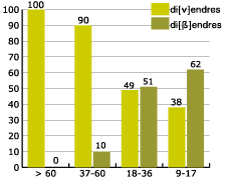 |
|
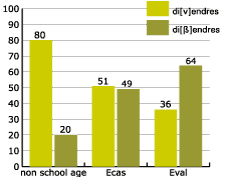 |
2.9 The africative [ ] ]
The fricative
sound [ ] forms part of the repertoire of phonemes in
the traditional language model of the Baix Vinalopó. The modification of this sound is
numerically quite small and only found in the youngest age group: ] forms part of the repertoire of phonemes in
the traditional language model of the Baix Vinalopó. The modification of this sound is
numerically quite small and only found in the youngest age group:
Figure19.
Percentage by age of realisation of the volced palatal fricative: dijous
(Thursday)
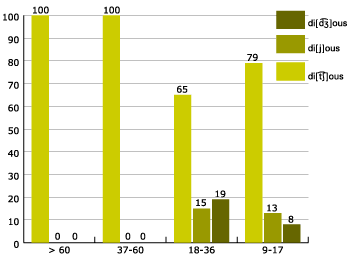
We found two
different sounds replacing it. On the one hand, there is the devoicing [ ], current for
long in central Valencian and much more recently occurring in different areas in the
neighbouring county of Valls del Vinalopó. Secondly, there is the de-affricativisation of
the sound resulting in a sort semiconsonant [ ], current for
long in central Valencian and much more recently occurring in different areas in the
neighbouring county of Valls del Vinalopó. Secondly, there is the de-affricativisation of
the sound resulting in a sort semiconsonant [ ].This phenomenon is detectable also in the neighbouring
county of Alacantí. ].This phenomenon is detectable also in the neighbouring
county of Alacantí.
As can be seen in
figure 19, devoicing is more habitual among the young adult group: it occurs at more than
20% in their replies. This tendency decreases sharply in the youngest age group (8%). Loss
of afficativisation, in contrast, is much less habitual among this youngest or school-age
group. Even so, school-agers tend to avoid both pronunciations, which together amount to
22% of the replies, while among the young adults this combined feature amounts to 34%.
Devoicing affects
some of the localities in the rural areas around Elx and in the town itself; the loss of
affricativisation is distributed across areas or individuals with strong Spanish influence
(Elx, Santa Pola, Guardamar, la Marina). In figure 20 it can be seen that where the
interviewee claims high use of own language, this favours considerably the realisation of
the devoiced affricative [ ], while low use is associated with loss of
affricativization [ ], while low use is associated with loss of
affricativization [ ]: ]:
Figure
20. Realisations according to declared own use of Catalan, of the voiced palatal
affricative: dijous (Thursday)
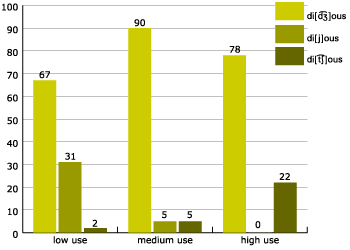
Such a pattern
could lead one to interpret the two types of phonetic replacement as the result of
interference from Spanish but in different contexts: devoicing [ ] appears in a language situation where Catalan has a degree of
vitality, while loss of affricativisation [ ] appears in a language situation where Catalan has a degree of
vitality, while loss of affricativisation [ ],
tends to occur in social circles more heavily affected by Spanish. And indeed, this last
is a normal adaptation of the sound [ ],
tends to occur in social circles more heavily affected by Spanish. And indeed, this last
is a normal adaptation of the sound [ ] of Catalan or
English, let us say, as made by Spanish speakers, while the other variant began in central
Valencian at a moment of great linguistic vitality, in the 17th and 18th centuries. ] of Catalan or
English, let us say, as made by Spanish speakers, while the other variant began in central
Valencian at a moment of great linguistic vitality, in the 17th and 18th centuries.
There are no
notable differences depending on school syllabus. Notice, however, that devoicing is more
frequent among Eval subjects where it affects some 16% of the responses, precisely
in those who state that they make greater use of their own language. The loss of
affricativisation is associated with Lval subjects —11%— and low use of
Catalan. Both tendencies affect rural and urban localities more or less indistinctly,
while the voiceless variant is more common in the country where once again linguistic
vitality is greater.
2.10 The –lt final group before vowels
The traditional
way of realising the consonant cluster –lt followed by a vowel in the county
is not to delete the dental and thus to pronounce it mo[lt a]mable
("very kind"). We detect a degree of /t/ deletion in this position, thus
coinciding with the traditional model of neighbouring counties, part of Valls del
Vinalopó, the Foia de Castalla and Alcoi. In the Baix Vinalopó, deletion occurs at 19%
for the overall population of the county.
As can be seen in
figure 21, deletion of the dental is quite frequent among the school-aged speakers
—at 39%— and reduces as one moves up the age range: it occurs in 23% of the
replies from the young adults, only 1% of the replies from the adults, and occurs not at
all among the elderly:
Figure
21. Percentage by age of realisations of t final clusters in syntactic phonetics:
molt amable (very kind)
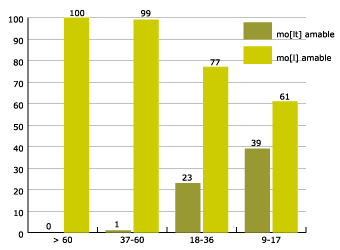
This feature is
found regularly in all localities, without significant distinctions. Patterns of deletion
are not related to school syllabus either.
Given the
existence of this in the population that has not received schooling (in Catalan) and the
non-effect in this case of the type of schooling received, we ascertain that deletion of
the dental must be an incipient process in the colloquial model, irrespective and
independent of the process of convergence with Spanish or interdialectal levelling caused
by the inroads from the extension of standard.
2.11 Loss of intervocalic -d
Since the loss of d
intervocalically is a major feature of this dialect, the questionnaire included several
items in relation to it. On the one hand, there are items with closely similar equivalents
with the d in Spanish (esternudar, oblidar-olvidar, vida, saludar, roda, redona,
cadena, madur, quedar) and, on the other, there are those that lack such equivalents (cadira,
Nadal, neboda).
We observed a
notable difference between the two sets of words: in the group with no closely similar
cognate in Spanish (see figure 22), the presence of the d —which will always
be a reinsertion from the point of view of the traditional model— is not found at all
in the elderly, and at a low level in the adults. The rate increases considerably with the
young adults and with the school children it is actually present in the majority of the
cases (more than 60%).
In the group with
close equivalents in Spanish (see figure 23), the reintroduction reaches 20% for the
combined adults and young adults, with a slight increase as one moves down the age group.
School children, lastly, realise the d three quarters of the time.
Figure 22. Percentage by age for
intervocalic d in words with no similar cognate in Spanish (Nadal (Sp.
Navidad) , neboda (Sp. sobrina), cadira(Sp. silla) |
|
Figure 23. Percentage by age for
intervocalic d in words with similar cognate in Spanish (esternudar,
olvidar-oblidar, vida, roda, saludar, redona, cadena, madur, quedar) |
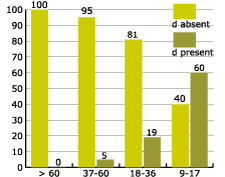 |
|
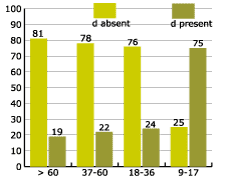 |
Reintroduction of
the dental is closely related to schooling in Catalan (Eval), above all for
individuals in Elx, who (as a result of heavy Spanish inroads) use less Catalan both in
the family and socially. We see that with Eval subjects frequency of use of the
innovation is three times greater than their own local traditional model without d, both
in the words that have no close Spanish equivalent and those that have. Even so, the
dilution of the traditional model is more patent than in this second group of words:
Figure 24. Percentage by type of
school syllabus for intervocalic d in words with no similar cognate in Spanish (Nadal
(Sp. Navidad) , neboda (Sp. sobrina), cadira (Sp. silla) |
|
Figure 25. Percentage by type of
school syllabus for intervocalic d in words with similar cognate in Spanish (esternudar,
olvidar- oblidar, vida, roda, saludar, redona, cadena, madur, quedar) |
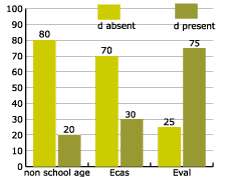 |
|
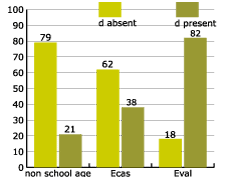 |
Generalisation of
the disappearance of the intervocalic d is a very much established feature of the
speech of the county. At the same time, however, it has carried low prestige for some
time, and is stigmatised even, for the lack of correspondence with the Spanish standard
and the varieties of Valencian Catalan spoken in neighbouring counties. This explains the
reintroduction of the d after being absent traditionally for a long time, because
both the factors in question encourage the reintroduction of the d. In this case,
Spanish is not the sole determining factor, as it has been in the other cases. Rather, it
has joined forces with the pressure of neighbouring dialects —and thus with a trend
that was already colloquial —and, more recently, with normative Catalan.
At all events, it
should not be overlooked that it is precisely those school children who find themselves in
a more heavily Spanish influenced environment that are the most disposed towards this
reintroduction. In this group the colloquial tendency to replace the dental has been
enhanced both by pressure from Spanish, breaking with the traditional model and the influx
of the normative model of Catalan. |
